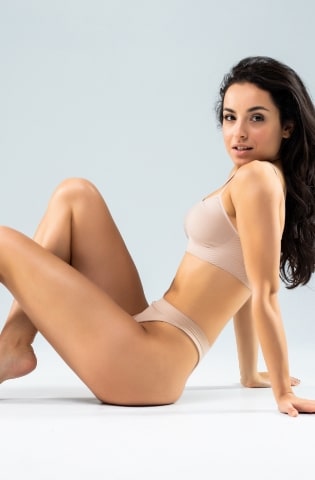Liposuction of the upper hips can be very effective. The best candidates have excess fat with very little loose skin or stretch marks. This area is also frequently referred to as “muffin top liposuction” or “spare tire liposuction”.
How Long Does the Upper Hip Liposuction Procedure Take?
Vaser liposuction is an outpatient procedure that can take one to two hours. You may be in the surgical suite for a slightly longer period for pre- and post-op observation as needed. During your consultation or pre-surgical office visit, the doctor will review your surgery and prepare you for how long you should expect to be at the facility. You may need to provide this information to a loved one who will pick you up at the surgery center and drive you home.
What is the Recovery Like After Upper Hip Liposuction?
Liposuction is a fairly conservative plastic surgery procedure that may require just a few days of downtime. You may experience mild to moderate pain after your surgery. Over-the-counter or prescription medication can efficiently manage this side effect. Swelling is also common. To help the swelling and bruising subside, you'll need to wear compression for at least a few days. Your post-op care instructions may discuss when you can remove your compression for showering and incision care, and how long you should maintain wear.
As soon as a few hours after you return home, you may walk short distances. First, you may need to walk only around the house. By the following day, you may extend your walks around your neighborhood. Do not overdo physical activity. While walking can help improve circulation and lymph drainage, there is no rush to return to your normal workout schedule. To help your body heal efficiently from your hip liposuction, you may eat a nutritious diet with lean proteins and lots of fresh vegetables, get plenty of rest and sleep, and stay well hydrated.
Can I Exercise After My Upper Hip Liposuction Procedure?
You will be able to walk soon after your hip liposuction procedure. However, you must refrain from doing too much. You may feel more tired than usual after having this procedure. Even though liposuction is conservative, there are still changes occurring to your body's superficial infrastructure. To heal the minor changes, your body may expend more than its normal amount of energy. It's important that you listen to its needs. For at least a week, keep your exercise routine to walking around the block or around your local vicinity. Walking several miles is not necessary to support your surgical recovery. When you do return to your normal workouts, start at only about one-quarter of your norm and increase from there. Also, when you resume your exercise habits, take it easy on the hip and buttocks area. Pay close attention to how you feel when working out and, if discomfort occurs, stop.
Are there any Risks from Upper Hip Liposuction?
Hip liposuction carries the same risks as all liposuction surgeries. These are minor. Complications are very rare. During your consultation, Dr. York will go over the risks that you need to be aware of, including:
- Excessive bleeding
- Infection
- Contour irregularities
- Changes to the appearance of the skin, such as waviness
- Prolonged pain or sensations caused by nerve damage
- Fluid accumulation beneath the skin (seroma)
I have loose skin on my upper hips, am I a candidate for Liposuction?
Loose skin can be tightened with liposuction to a small degree. If the excess skin is significant a thigh lift or buttock lift may be the procedure of choice.
You may be a good candidate for liposuction if the amount of laxity on your skin is very minor. During your consultation, Dr. Yates will carefully evaluate the characteristics of your shape, fatty tissue, and skin to ensure that you achieve the most satisfying results from your treatment plan. Dr. Yates performs Vaser liposuction, which includes the use of ultrasound to heat and liquefy fat. In this instance, though, ultrasound energy does not provide sufficient heating of the dermis and connective tissue to stimulate tightening. If your skin is loose before liposuction, it may look looser afterward. This can happen not because the skin actually gets looser but because it loses some of the volume that gives it structure.
How is Upper Hip Liposuction performed?
Small incisions are used. The deep fat is removed with larger diameter cannulas. Treatment close to the skin requires small diameter cannulas. The upper hip area usually extends into the back as well.
What are other options to treat Upper Hip Fat?
CoolSculpting is a great nonsurgical alternative to liposuction. The results aren’t as dramatic as liposuction but there is no downtime and it is less costly.
What post-op care is involved with Upper Hip Liposuction?
You will receive detailed post-op instructions to follow after your liposuction procedure. It is imperative that you understand your instructions and contact us if you have any questions. Generally, post-op care revolves around fostering optimal recovery and caring for the incisions that were made. Liposuction incisions are incredibly small but require attention to prevent infection and scarring. Your care instructions may recommend using gentle soap or antibacterial soap to wash the surgical area at least once a day. The skin should be patted dry, not rubbed, and a bandage may need to be in place for a few days. During your post-op period, you can eat normally but must avoid alcohol consumption for at least two days. You should also refrain from smoking and using tobacco products. It is important to wear the compression garment to encourage skin reshaping after liposuction of the upper hips. The garment should be worn day and night as much as possible for 3 weeks after surgery.
What kind of anesthesia is used for Liposuction of the thighs?
Liposuction of the upper hips generally requires sedation and tumescent local anesthesia.

